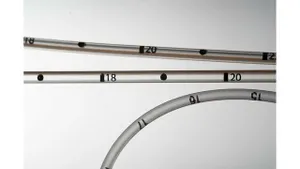LNP Anticipates Higher Profile Under GE Plastics Ownership
April 30, 2003
Thermoplastics compounder LNP Engineering Plastics Inc., Exton, PA (and Raamsdonksveer, Netherlands), is aim-ing for heady 20%/yr-plus sales growth, now that it is backed by GE Plastics. The compounder, acquired in March 2002 by the Pittsfield, MA-based engineering thermoplastics giant, says it is on track to double sales (from about $400 million last year) by 2005.
Bernhard Lanham, president and managing director of LNP in Europe, says the firm plans to invest about $40 million in facilities from 2002 to 2005 to expand capacity. Much of this investment will go toward increasing the range of compounds produced at each of the nine LNP plants, including three that were part of GEP's Custom Engineered Products (CEP) division, which primarily compounded amorphous materials. LNP's strength is compounding of crystalline materials. Cees Nieuwenhuizen, manufacturing and engineering director, says the investment should help ensure that each site can quickly meet local orders for at least 30 to 40 compounds.
LNP has seven product lines based on compounded effects such as thermal conductivity and internal lubrication. It also produces custom formulations with multiple features, such as conductive colored compounds.
Last year, the information technology market accounted for about 40% of company sales, followed by automotive (23%), industrial (14%), and electrical/electronics (11%). By 2005, the mix is expected to change to 32% IT, 28% automotive, 15% industrial, and 16% E/E. Some of the drop in IT share is expected to be from OEMS switching from etp compounds to less-costly materials based on commodity polymers. LNP intends to remain focused on high-margin materials and businesses.
LNP faces a host of strong competitors, including RTP Co., PolyOne Corp., and A. Schulman Inc. Lanham argues that GEP is its new trump card, as it is the only global compounder that is backward-integrated with a leading etp supplier. This enables LNP to purchase plastics at lower rates, which potentially gives it advantages in end-prices and margins.
Perhaps more significant is that GEP can get LNP into product development upstream in the manufacturing chain, a goal of practically every supplier. For instance, before being acquired, Lanham says LNP was well-known among Tier 2 automotive suppliers and some Tier 1 firms, but had little contact with carmakers. Now, LNP's offerings are being promoted in the earliest stages of vehicle development by GEP's key account managers assigned to each carmaker.
This is significant, explains Lanham, since, typically, carmakers directly specify materials for large structural parts like front-ends. Robert Puyenbroek, technology manager, calls this "getting beyond the design space," meaning that in contrast to being simply a supplier, LNP can be a value-added member of the product development team, providing materials knowledge and recommendations.
Despite its ties to GEP, Lanham says the compounder will remain independent. "If another [polymer] supplier offers a better material for a specific application, obviously we will use it," he notes. But, all things being equal, GEP materials will be exploited.
As a significant amount of automotive, information-technology, and electronics part processing moves to Asia and Eastern Europe, many compounders are moving too, to ensure that manufacturers have local supplies.
Last October, RTP, Winona, mn, officially opened its first Asian production facility, in Singapore, and in March it opened its first direct sales representative office in China. In February, A. Schulman opened its first sales and marketing office in Japan to serve the domestic automotive market.
LNP, too, is increasing its presence in Asia. Late last year, it began installing two additional compounding lines at a former CEP facility in Shanghai. Early this year, a 15% capacity expansion was completed at its own site in Malaysia.
Lanham says the firm is eyeing expansion opportunities in Eastern Europe, be they greenfield investments or acquisitions, and developments before year end are possible. LNP closed its facility in Santa Ana, CA, early last year as it part production shifted to Asia, but completed a 50% expansion at its San Luis Potosi, Mexico, site.
You May Also Like


